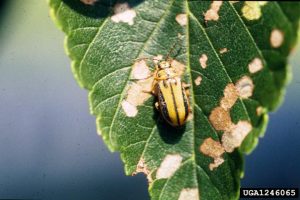
Photo Credit: Whitney Cranshaw Colorado State University
By far, the most common yard and garden call coming into the Extension office this summer has been homeowners that are concerned about their Elm trees. The main symptoms being reported are leaves that have holes in them, and leaves that are dropping prematurely. Most of the calls have been coming from folks with Siberian Elms.
The cause of this widespread damage is the elm leaf beetle. This insect has been present in the area for a while now, but this year seems to be a particularly bad year for them.
If you have Siberian Elms, you might be experiencing damage from elm leaf beetles as well. The beetles themselves are small, yellow beetles with black stripes. You may also notice the larva which are small black larva with yellow markings on their backs. Elm leaf beetle adults do tend to move into homes in late summer/early fall as well. They don’t cause any damage in homes, and do not breed indoors.
If you do suspect damage on your elms from elm leaf beetle, there are some options for control. If you have an otherwise healthy tree, you could practice good tree care to promote its general health and help it to naturally overcome the pests. They aren’t typically deadly to a tree that is otherwise in good health. To promote a healthy tree, irrigate at the drip line of the tree during the growing season and during the fall and winter. Don’t allow landscape fabric or mulch to remain up against the trunk of the tree.
If you feel that you do need to treat your tree, there are a few options. A soil applied systemic insecticide is a good option that most homeowners can do on their own. Look for the ingredients Imidacloprid or Chlothianidin. These products will be watered into the soil below the tree and be taken up into the leaves.
You can also use a product that is sprayed onto the leaves of the tree. Most Elms are quite large so this may require hiring a tree service. These products are best applied in late May/early June, so at this point it would be something to consider for next year. The ingredients to look for would include Azadirachtin, bifenthrin, carbaryl, permethrin, or Spinosad.
The final option would be trunk banding. This involves spraying a band of insecticide on the trunk to kill larva that crawl to the base of the tree. Bands should be one foot wide and sprayed just below the lowest branches. Ingredients to look for would include bifenthrin, permethrin, or cyfluthrin.
For any product that you use on your trees, be sure to read and follow the label exactly. Also be sure the product is labeled for use on elm trees and for control of elm leaf beetles.


